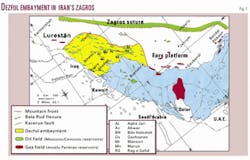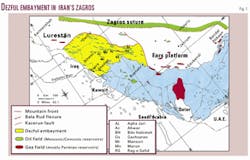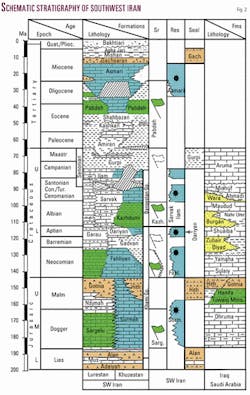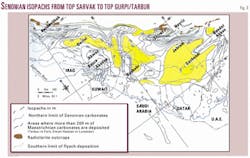M.L. BordenaveThe Iranian part of the Zagros Foothills and of the Persian Gulf is one of the world's most prolific oil and gas provinces. According to official figures, 93 billion bbl of oil and 810 tcf of gas would be recoverable, which correspond to 9% and 15% of the global reserves, respectively.
Petroleum consultant
Paris
The Zagros Domain and Iranian waters have been underexplored for the last 20 years. Petroleum exploration almost ceased in 1979 as the result of the Iranian revolution and subsequently of the Iran-Iraq war.
Exploration drilling resumed in 1989 but at a relatively slow pace. National Iranian Oil Co. drilled a few oil prospects and chalked up a good success ratio. Several oil and gas discoveries onshore and the extension in Iranian waters of huge North Dome gas field of Qatar confirm the remaining potential of the country.
An impressive gathering of giant oilfieds, such as Ahwaz, Agha Jari, Bibi Hakimeh, Gachsaran, Mansuri, Marun, and Rag-e Sefid, is located in a relatively small area, only 50,000 sq km, inside the Dezful embayment of Khuzestan Province (Fig. 1). These fields, which produce from the Asmari limestone of Early Miocene and the Sarvak limestone of Cenomanian (Fig. 2), contained more than 350 billion bbl of original oil in place and 250 tcf of associated gas.
By contrast, gas reserves in excess of 300 tcf, found in Permo-Triassic reservoirs, are widely distributed from Lurestan to the Bandar Abbas area in eastern Fars Province. A large part of these reserves is located in Iranian waters of the Persian Gulf.
The distribution of these huge accumulations of oil and/or gas is explained by the superposition of two main petroleum systems, i.e., a Paleozoic System and a Middle Cretaceous to Early Miocene System. These generally do not interfere with each other, as they are separated by a thick and widespread seal formed by the Dashtak formation of Triassic age. Other petroleum systems play a relatively minor role in the Iranian gas and oil accumulations.
Paleozoic System
The Paleozoic Petroleum System is related to Silurian source rocks, which are well known in Saudi Arabia and outcrop in Iran, north of Banbar Abbas.
Extensive geochemical modeling has shown that oil generation began at the end of Jurassic in some areas, while the onset of the gas window was reached locally as early as the Middle Cretaceous.
A suite of cumulative isopachs makes it possible to visualize the evolution of the maturity of the source rocks through time. It also provides a reliable image of the geometry of the reservoirs and allows the location of the oil and gas accumulations prior to the Zagros orogeny. Oil and later gas migrated over long distance and accumulated on continuous regional highs (Fig. 3). Huge amounts of gas, and perhaps limited quantities of oil, later reaccumulated in the Zagros folds, formed during Late Miocene and Pliocene.
The characteristics of potential reservoirs, namely the Dalan formation of Permian age and the Early Triassic Kangan formation, and the areal extent of the Dashtak formation, which seals the system, could be deduced from paleogeographic reconstructions, including the distribution of facies and isopachs.
The distribution of the reservoirs and of the seals, together with the present day distribution of the gas fields, of the surface oil and gas seepages, and hydrocarbon-related indications, make it possible to select, among the numerous Permo-Triassic prospects which remain undrilled, those which are the most attractive.
About 50 prospects are worthy of consideration based on their size, type of structure, depth of objective, reservoir characteristics, expected gas-in-place in case of discovery, and estimated success ratio. The gas-condensate ratio may be high in some areas. In addition, some prospects may contain a light oil ring below the gas.
Mid-Cretaceous-Early Miocene
This system is dominated by the outstanding Kazhdumi source rocks of Albian age, which were deposited in a depression which corresponded almost exactly to the present Dezful embayment. More than 90% of the oil reserves found in Iran are derived from the Kazhdumi.
Minor contributions to the feeding of some of the main fields were made by another source rock, the Pabdeh formation of Eocene age, where it reached a sufficient maturity. In the northeast part of the Dezful embayement, a few mid-sized fields were formed from oil of Padbeh origin only.
Modeling could be extensively used to determine the time of the onset of the oil window, oil expulsion, and the beginning of gas generation. The time of oil expulsion for the two source rock layers was found to commence after the beginning of the Zagros folding. Therefore, the migrations took place almost vertically and were facilitated by a fracturing particularly intense in high-relief anticlines.
The distribution of the source rocks, their thickness, organic characteristics, and maturity could be used to forecast if an undrilled structure is expected to be oil, gas, or water-bearing, and when oil is expected, what would be the order of magnitude of the oil in place to be found.
The characteristics of the main reservoirs of the Asmari and Sarvak formations could be estimated from their facies distributions and isopachs. The isopachs clearly show during the Cretaceous, the individualization of a succession of N-S oriented highs and lows (Fig. 3) where platform and basinal facies, respectively, were deposited.
The role of the evaporitic seals, and especially the Gachsaran formation, is important, but the ability of mature organic-rich source rocks to act as a seal should be considered where they are overpressured, mainly as the result of the oil generation. This geochemical aspect, together with the shape of a structure, explains why the Asmari and Sarvak reservoirs are interconnected in some fields and separate reservoirs in other fields.
Other petroleum systems
Two other petroleum systems played a relatively minor role, although of local importance, in the formation of the Iranian oil and/or gas fields.
The first system is related to the rich Sargelu source rocks of Middle Jurassic age, deposited in the Mesopotamian-Lurestan depression, which at the time extended over the western part of the Dezful embayment. This source rock is limited, above and below, by thick anhydritic layers and could not feed any valid reservoirs in the depression.
However, some oil originating from the Sargelu has migrated laterally, towards regional highs located on the edge of the Dezful embayment, before the Zagros folding. Later, this oil moved into the Zagros folds. A few prospects, some of large size, where economic accumulations of light oil originated from the Sargelu formation, remain to be drilled.
The second system is related to the rich source rocks of the Garau formation, deposited during the Neocomian, in Lurestan and in the western part of the Dezful embayment. Almost everywhere in Lurestan, the Garau source rocks are not associated with any reservoirs, except on its southern border, where two small fields, Sarkan and Maleh Kuh, were charged by the Garau source rocks. As for the Sargelu Petroleum System, some Garau oil accumulated, before the Zagros orogeny, on local highs located on the edge of the Dezful embayment. Several prospects related to the Garau source rocks remain to be drilled.
Exploration opportunities
Several dozens of potentially oil-bearing structural prospects, some of which may contain more than 1 billion recoverable bbl, remained to be drilled.
Moreover, the application of modern seismic technology should help to define further more prospects in the extremely prolific Dezful embayment, i.e., low-relief Zagros folds in between the main fields, and N-S pre-Zagros very gentle elongated structures. A few stratigraphic leads, considered as difficult but with a large potential reward, as well as new oil plays, such as the exploration for light oil from Silurian origin, remain untouched.
The perspective is even brighter for gas exploration. Some 50 valid prospects, located either in Fars or Lurestan, could contain each gas reserves of between 5 and 20 tcf. The probabilities of discovery, although being highly conjectural, were estimated to vary from 5% to 50% according to the prospects, with an average of 20%. The expected gas reserves to be found may reasonably be comprised between 50 and 150 tcf or even more.
Another type of opportunity results from the drastic decline of the reservoir pressure in most of the main fields.
NIOC proposed several enhanced oil recovery projects that would require massive gas injection to restore the field producing capabilities, increase recovery factors, and add new reserves. Such projects are synonymous with heavy investments in the fields themselves and also to produce, transport, and inject the gas, originated either from undeveloped existing fields or better as the result of future exploration.
The Author
M.L. Bordenave is an exploration geologist, retired from Total, with 40 years' experience in geology, geophysics, and geochemistry. Among other assignments, he worked in Tehran as head of research for Iranian Oil Exploration and Producing Co. (IOEPC), then as exploration coordinator for the Middle East region representing Total at OSCO, ADPC, ADMA, DPC, and PDO. He was exploration manager and local representative for Total Petroleum in Houston and exploration manager for Total Indonesie in Jakarta. E-mail: [email protected]





